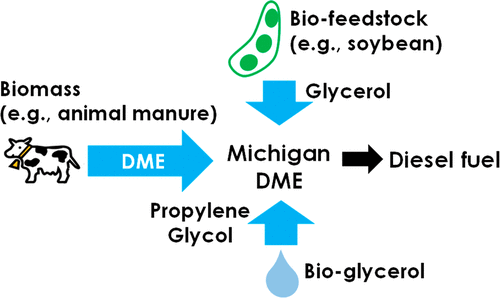当前位置:
X-MOL 学术
›
ACS Sustain. Chem. Eng.
›
论文详情
Our official English website, www.x-mol.net, welcomes your feedback! (Note: you will need to create a separate account there.)
Life-Cycle Greenhouse Gas Emissions Assessment of Novel Dimethyl Ether–Glycerol Blends for Compression-Ignition Engine Application
ACS Sustainable Chemistry & Engineering ( IF 8.4 ) Pub Date : 2021-09-22 , DOI: 10.1021/acssuschemeng.1c03783 Taemin Kim 1 , André L. Boehman 1
ACS Sustainable Chemistry & Engineering ( IF 8.4 ) Pub Date : 2021-09-22 , DOI: 10.1021/acssuschemeng.1c03783 Taemin Kim 1 , André L. Boehman 1
Affiliation

|
A life-cycle greenhouse gas (GHG) emissions assessment is conducted on a novel, stable dimethyl ether (DME)–glycerol blend with propylene glycol (PG) cosolvent (i.e., Michigan DME blend II) with its DME content ranging between 40–50 wt %. The ratio of PG to glycerol is fixed at the minimum cosolvent to glycerol mass ratio (MCR) at each DME wt %. The system boundary of the assessment contained 7 different processes: (i) crude glycerol production; (ii) glycerol purification; (iii) PG production; (iv) DME production; (v) Michigan DME blending; (vi) Michigan DME blend transportation; and (vii) pump-to-wheels combustion. Twelve different pathways are established (i.e., 3 different cases for glycerol purification process and 4 different cases for DME production process) for the production of unit mass (1 kg) or unit energy (1MJ) of Michigan DME blend II, and the results are compared with each other. The pathway using high-purity crude glycerol product for glycerol purification (Case C) and DME production from animal manure (Case 4) showed the lowest well-to-wheels (WTW) GHG emissions (i.e., 45.8 gCO2e/MJ), which achieved about 50% GHG reduction from the petroleum-based diesel baseline. The pump-to-wheels combustion process was the biggest GHG emitting process (i.e., 34% of the WTW GHGs) for fossil-based DME cases while the crude glycerol production process was the biggest GHG emitting process (i.e., 44–55% of the WTW GHGs) for renewable DME cases. Propylene glycol production (i.e., 32% of WTW GHGs for renewable DME cases) and glycerol purification (i.e., 4–15% of WTW GHGs) also accounted for a significant portion. Adoption of regenerative farming methods, use of less carbon intensive hydrogen for PG production, and more efficient material and thermal energy utilization are suggested as the potential solutions to further reduce GHG emissions from the current LCA result of the Michigan DME blend II.
中文翻译:

用于压燃式发动机应用的新型二甲醚-甘油混合物的生命周期温室气体排放评估
生命周期温室气体 (GHG) 排放评估是对一种新型稳定的二甲醚 (DME)-甘油与丙二醇 (PG) 助溶剂(即密歇根 DME 混合物 II)进行的,其 DME 含量范围在 40-50 之间重量%。PG 与甘油的比率固定在每个 DME wt % 的最小共溶剂与甘油质量比 (MCR)。评估的系统边界包含 7 个不同的过程:(i) 粗甘油生产;(ii) 甘油纯化;(iii) PG 生产;(iv) 二甲醚生产;(v) 密歇根二甲醚混合;(vi) 密歇根二甲醚混合运输;(vii) 泵轮燃烧。为生产单位质量(1 kg)或单位能量(1MJ)的密歇根二甲醚混合物 II,建立了 12 种不同的途径(即,3 种不同的甘油提纯过程和 4 种不同的二甲醚生产过程),并将结果相互比较。使用高纯度粗甘油产品进行甘油纯化(案例 C)和从动物粪便中生产二甲醚(案例 4)的途径显示最低井到车轮 (WTW) 温室气体排放(即 45.8 gCO2 e/MJ),与基于石油的柴油基准相比,温室气体减少了约 50%。对于基于化石的 DME 案例,泵到轮燃烧过程是最大的 GHG 排放过程(即 WTW GHG 的 34%),而粗甘油生产过程是最大的 GHG 排放过程(即 44-55% WTW GHGs) 用于可再生 DME 案例。丙二醇生产(即,可再生二甲醚情况下 WTW GHG 的 32%)和甘油纯化(即 WTW GHG 的 4-15%)也占很大一部分。建议采用可再生农业方法、使用碳密集度较低的氢气生产 PG,以及更有效的材料和热能利用,作为进一步减少密歇根二甲醚混合物 II 当前 LCA 结果产生的温室气体排放的潜在解决方案。
更新日期:2021-10-04
中文翻译:

用于压燃式发动机应用的新型二甲醚-甘油混合物的生命周期温室气体排放评估
生命周期温室气体 (GHG) 排放评估是对一种新型稳定的二甲醚 (DME)-甘油与丙二醇 (PG) 助溶剂(即密歇根 DME 混合物 II)进行的,其 DME 含量范围在 40-50 之间重量%。PG 与甘油的比率固定在每个 DME wt % 的最小共溶剂与甘油质量比 (MCR)。评估的系统边界包含 7 个不同的过程:(i) 粗甘油生产;(ii) 甘油纯化;(iii) PG 生产;(iv) 二甲醚生产;(v) 密歇根二甲醚混合;(vi) 密歇根二甲醚混合运输;(vii) 泵轮燃烧。为生产单位质量(1 kg)或单位能量(1MJ)的密歇根二甲醚混合物 II,建立了 12 种不同的途径(即,3 种不同的甘油提纯过程和 4 种不同的二甲醚生产过程),并将结果相互比较。使用高纯度粗甘油产品进行甘油纯化(案例 C)和从动物粪便中生产二甲醚(案例 4)的途径显示最低井到车轮 (WTW) 温室气体排放(即 45.8 gCO2 e/MJ),与基于石油的柴油基准相比,温室气体减少了约 50%。对于基于化石的 DME 案例,泵到轮燃烧过程是最大的 GHG 排放过程(即 WTW GHG 的 34%),而粗甘油生产过程是最大的 GHG 排放过程(即 44-55% WTW GHGs) 用于可再生 DME 案例。丙二醇生产(即,可再生二甲醚情况下 WTW GHG 的 32%)和甘油纯化(即 WTW GHG 的 4-15%)也占很大一部分。建议采用可再生农业方法、使用碳密集度较低的氢气生产 PG,以及更有效的材料和热能利用,作为进一步减少密歇根二甲醚混合物 II 当前 LCA 结果产生的温室气体排放的潜在解决方案。


























 京公网安备 11010802027423号
京公网安备 11010802027423号